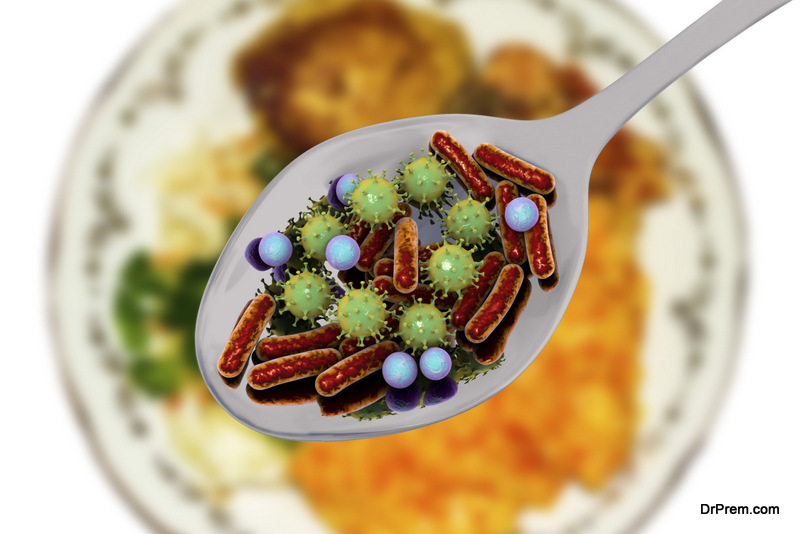Food is a part of everyday life, providing us with the nutrition and energy we need to survive and flourish. But that doesn’t mean we can eat everything and anything without caution or care. Not only is obesity a real concern, but there are countless foodborne illnesses that can cause serious medical complications if gone untreated. Your best defense against these illnesses is prevention and knowledge. Learn here about the most common foodborne illnesses and how to lower your risk of contracting them.
1. Salmonella
 Salmonella is one of the most common foodborne illnesses and is spread through raw meats, specifically poultry and pork. But it’s important to first understand where salmonella originates. This illness is actually found in the intestines of pigs and poultry and then spread through their feces. That doesn’t mean that direct contact with contaminated animal feces will cause salmonella. In fact, it’s easily spread through the water used to irrigate crops. If contaminated feces enter the water used for irrigation, it can contaminate the crops and enter the public market. If salmonella is in the raw meats used in your kitchen, it can easily spread. This is why thoroughly washing your hands, countertops, cutting boards, and knives used to handle any raw poultry or pork is so important.
Salmonella is one of the most common foodborne illnesses and is spread through raw meats, specifically poultry and pork. But it’s important to first understand where salmonella originates. This illness is actually found in the intestines of pigs and poultry and then spread through their feces. That doesn’t mean that direct contact with contaminated animal feces will cause salmonella. In fact, it’s easily spread through the water used to irrigate crops. If contaminated feces enter the water used for irrigation, it can contaminate the crops and enter the public market. If salmonella is in the raw meats used in your kitchen, it can easily spread. This is why thoroughly washing your hands, countertops, cutting boards, and knives used to handle any raw poultry or pork is so important.
This cuts down on the potential spread of the bacteria. Learn more about food safety here. It’s important to note that salmonella can contaminate other animal products including milk, cheese, and eggs as well and even certain vegetables.
Pay close attention to any government recalls on contaminated products. Handling certain types of animals including frogs, turtles, and other reptiles may also lead to salmonella. Be sure to always wash your hands following contact with these types of animals.
Symptoms
There are several signs and symptoms associated with salmonella. Early detection can help you receive proper medical treatment. Because you can’t identify salmonella simply by looking at a food product or contaminated animal, paying close attention to the signs and side effects is key. Salmonella generally affects your digestive system, causing nausea, vomiting, and diarrhea.
Other common symptoms include a low grade fever and headache. These symptoms can occur anywhere between 12 and 72 hours following contact and discomfort can last upwards of one week. In some rare and more serious cases, it takes months for your digestive system to return to normal. Another rare but serious side effect of salmonella contamination is arthritis and joint pain.
Treatment
If you or someone you know has contracted salmonella, there is no quick cure. Generally, time, rest, and plenty of hydration can help salmonella work its way through your system. Consulting with a medical professional is recommended in case the infection spreads into your bloodstream. Other warning signs that your case of salmonella may need medical attention include a high fever, symptoms lasting more than 7 days, and bloody or severe diarrhea.
Even after you’ve been contaminated with salmonella, it’s important to wash your hands and practice proper hygiene. That’s because you can actually spread the disease through contact following a bowel movement without properly washing your hands.
2. E. Coli

E. coli is actually a healthy bacteria found in the intestines of humans and other animals. E. coli is generally harmless, however there are specific strains that can cause severe illness accompanied by stomach cramps, bloody diarrhea, and dehydration. Children and elderly individuals are at the highest risk for contracting these strains of E. coli.
The most common strain that causes illness is E. coli O157: H7. This strain damages the lining of the small intestine and is contracted through ingesting the bacteria found in certain foods. Even a small amount of this powerful bacteria strain can cause mild to severe discomfort in patients. The most common ways to contract E. coli are through ground beef, certain vegetables (including spinach and lettuce), unpasteurized milk, and contaminated water.
Similar to salmonella, E. coli is found in the intestines of animals. If this bacteria is present, it can be transferred to consumers. Human and animal feces contaminated with the E. coli virus can also contaminate local bodies of water used to irrigate crops. Private water sources are at greatest risk of contamination since they don’t have a disinfecting system.
Symptoms
Signs that you’ve contracted E. coli include abdominal cramping and tenderness to the touch, diarrhea which can be bloody and watery in nature, and some nausea and vomiting. Certain demographics are more at risk for contracting E. coli than others. High risk groups include young children and elderly adults and those with a weakened or compromised immune system or those with decreased stomach acids. It’s also been reported that E. coli is more apt to occur between the months of June and September.
Treatment
The only way to prevent E. coli is to prepare your food properly. This means cooking all meats to the recommended temperature, drink only pasteurized milks and juices, and wash all raw food products thoroughly before consuming.
3. Listeria

Listeria monocytogenes is a germ that causes a serious infection known as listeriosis. Listeriosis is found in certain foods including deli meats, hot dogs, meat and cheese spreads, unpasteurized milks and dairy products, and raw sprouts.
While the illness itself isn’t extremely serious, it can be for pregnant women because of the serious effects it has on the fetus and unborn child. For those infected, side effects of listeria include severe blood infections, brain infections, and discomfort in joints, chest, or abdomen.
Aside from pregnant women, individuals over the age of 65 and those with weakened immune systems are at greater risk of contracting the disease. But pregnant women must be especially careful. Once infected with listeria, the woman will experience flu-like symptoms, however once transferred through the placenta, listeria can cause miscarriage, premature delivery, stillbirth, and other life threatening infections to the unborn child.
Symptoms and Treatment
Symptoms for non-pregnant individuals include stiff neck, headaches, confusion, muscle aches, and fever. It’s important to note that it can take several days to several weeks for symptoms of listeria to surface. Once they do, a medical professional will run lab tests to diagnose the condition. Listeria is often treated using antibiotics.
Food handling and preparation are key when it comes to staying healthy and safe. Be sure to cook your food properly, clean your kitchen materials before and after use, and stay up to date on government recalls and warnings related to the above mentioned illnesses.
Article Submitted By Community Writer




